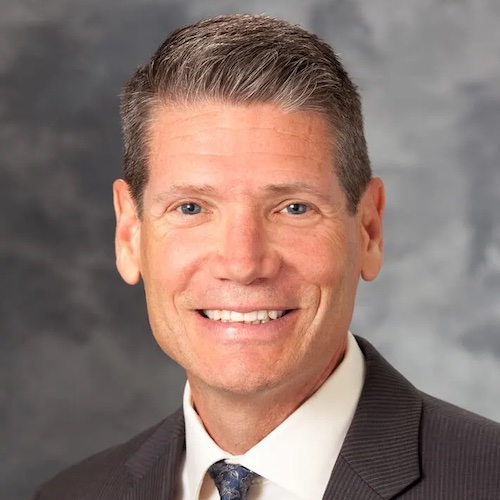
After medical school at the University of Wisconsin, Dr. Rongstad did his Orthopedic Surgery Residency at the University of Florida and Foot and Ankle Fellowship in California. He then returned home to Madison and has been in practice at the same location for nearly 25 years.
Dr. Rongstad is a Clinical Professor who treats a wide range of foot and ankle problems in adults and adolescents. He is a national leader in the lateral approach to total ankle replacement. He takes a thoughtful approach to complex foot and ankle deformity correction and is very experienced in ankle fracture fixation.
With such ankle and hindfoot expertise, many are surprised to hear of Dr. Rongstad’s interest in forefoot problems. His practice includes an ever-growing number of corrections of bunions, great toe arthritis and lesser toe deformities. As the word has gotten out, "Dr. Rongstad loves it!"
- Member, American Academy of Orthopedic Surgery 1995-present
- Member, American Orthopedic Foot Ankle Society 1995-present
-
Great toe arthritis (Hallux Rigidus)
- Joint implant vs. spur removal (ongoing study)
- Great toe fusion
-
Ankle arthritis
- Lateral approach total ankle replacement
- Ankle fusions
- All orthopedic problems of the ankle and foot to include the care of fractures, tendon ruptures, deformities and arthritis
- A keen interest in the treatment of bunions (hallux valgus) and arthritis of the big toe
- Community hospital hip fracture care on call
- Fellowship - Foot and Ankle
Roger Mann, MD, Oakland, CA, 1995-1996 - Residency - Orthopedic Surgery
University of Florida, Gainesville, FL, 1991-1995 - Internship - General Surgery
University of Florida, Gainesville, FL, 1990 - Medical Doctorate
University of Wisconsin School of Medicine, Madison, WI, 1990 - Bachelor of Science
University of Wisconsin, Madison, WI, 1986
- American Board of Orthopedic Surgery – Certified through December 2029
- Zimmer Trabecular Metal Total Ankle Arthroplasty
- Ankle replacement outcomes continue to improve over time. Learn more about ankle replacement.
- I use the Zimmer Trabecular Metal Total Ankle Replacement. Here are 2 videos:
- Patient results (2 minutes)
- Brief Technical guide (24 minutes)
- Read an overview of arthritis of the big toe (Hallux Rigidus)
- I am doing a study on spur removal and joint replacement for Hallux rigidus- this is fully approved by our IRB and can be discussed during the clinic visit.
- As an Orthopedic Surgeon in Wisconsin, I fix a lot of ankle fractures!
- I treat Achilles tendon ruptures (and had one myself!). I treat these both with or without surgery. Read more about surgical repair.
- I fix nearly 100 bunions per year, here is a summary of the operative and post-operative care:
Hallux Valgus Post Operative Expectations
Surgery for a bunion (hallux valgus) is usually done under local anesthesia with sedation. This means that the foot is "numbed" with an injected medication around the ankle after the patient receives a light sedative through a IV in the hand. Once the foot is numb, the surgery is performed in a surgical suite in the outpatient surgery center. The patient may have as much or little sedation as (s)he chooses during the procedure.
After the procedure, the patient is taken to the recovery area, where (s)he stays for about one hour to allow any sedation to diminish. Patients are usually able to go home the same day, but must have someone else drive. Walking on the heel with a special shoe is allowed in most cases as soon as it is tolerated. However, elevation is encouraged for the first several days to prevent swelling and discomfort. Narcotic pain medication is prescribed and should be used only as needed after surgery. Pain typically subsides within a few days after surgery, but there is some variation from person to person. Narcotic refills are not routinely prescribed.
There are several follow-up visits necessary after surgery. The approximate schedule and expectations are as follows: Sometimes, if all is going well, the follow ups after 6 weeks are only as needed.
2- 4 days after surgery:
Dressing removal and application of forefoot wrap. This is a "mini cast" made of tape to hold the toe in proper position.
10-14 days after surgery:
Removal of wrap and stitches, as well as x-rays. A new forefoot Wrap is then applied. Continue in special shoe, walking only on heel.
3 - 4 weeks after surgery:
Removal of wrap and re-application of new forefoot wrap.
5 - 6 weeks after surgery:
Removal of wrap and x-rays of foot. Based on the x-rays, a new wrap may or may not be applied.
7 - 8 weeks after surgery:
Discontinue special shoe and transition to supportive, somewhat rigid "normal" shoe (e.g. New athletic shoe, hiking boot, Birkenstock - type sandal.
12 weeks after surgery:
Return to fully normal activity as tolerated. It is not uncommon to experience some persistent swelling and/or mild discomfort for up to 6-12 months after surgery (usually with aggressive activity or prolonged standing/walking).
1 S. Park Clinic
Phone: (608) 263-0110
East Madison Hospital
Phone: (608) 263-0110
